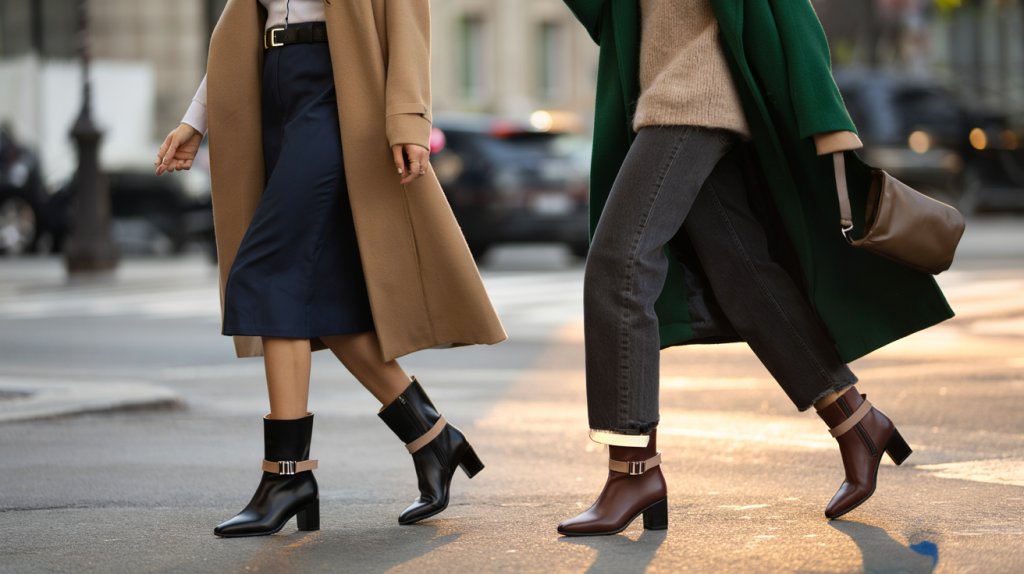The belt on a boot changes everything. Elegant belted boots for women cinch the shaft, frame the ankle, and sharpen lines without shouting. That small strap creates balance with skirts, tempers wide denim, and gives tailored coats a clean finish.
Good news for real life wardrobes : this design flatters more leg shapes than expected, works from office to dinner, and looks polished with almost any hem. The essentials arrive fast here. Choose refined hardware over heavy buckles, a stable mid heel around 4 to 6 cm for all day wear, and a shaft height that meets your hem rather than fights it.
Why elegant belted boots are back : context, utility, style
Designers revived the cinched shaft because it sculpts the silhouette and solves a common problem : boots that feel bulky around the calf. The belt keeps volume closer to the leg, so outfits read streamlined rather than heavy.
There is also a practical side. Adjustable straps help fine tune fit after socks or under layered tights, which reduces the risk of heel slip and blister points. That small fastening quietly upgrades comfort without changing the look.
Shoppers care about getting fit right when buying footwear online. The National Retail Federation reported a 17.6% return rate for online purchases in 2023 and a 14.5% overall return rate in the U.S. according to its December 2023 report with Appriss Retail. Source : NRF 2023 Retail Returns.
How to wear women’s belted boots : simple outfit formulas that work
Start with length. Knee high belted boots align with midi skirts for a continuous line, while ankle pairs love straight or wide jeans cropped just above the strap so the detail shows. Neutral leather reads elevated with minimal effort.
Hardware matters. One slender strap and low profile buckle looks refined with tailoring and slip dresses. Double straps on a chunky sole lean casual, ideal for knits and relaxed denim. The belt should echo something up top, like a waist belt or bag strap, so the eye connects the dots.
Color locks the look. Black offers the sharpest outline, dark brown softens, and warm tan lifts navy or charcoal. If the outfit mixes textures, let the boot leather be the calm surface and keep the strap tone on tone for a clean finish.
Fit, sizing and comfort : avoid the usual mistakes
The biggest headache is calf fit. Measure the widest part of each calf in centimeters while standing in the afternoon, then compare to the boot circumference listed by the retailer. A strap that can tighten by 1 to 2 cm is a real ally on in between days.
Sizing conversions vary by region. If converting sizes, refer to the international guidance in ISO/TS 19407 :2015, which documents how sizing systems map across markets. Source : ISO/TS 19407 :2015.
Material thickness affects support. Leather is often described in ounces, where 1 ounce equals about 0.4 mm. That means a 4 to 5 ounce upper is roughly 1.6 to 2.0 mm, a versatile range for city boots that need structure without stiffness. Source : Wikipedia Leather.
Checklist before you buy :
- Strap position : at or just above the ankle narrows the line, mid shaft straps add edge yet can cut the leg visually.
- Heel height : 4 to 6 cm for long days, block shapes feel steadier than stilettos on uneven sidewalks.
- Shaft meeting point : match the top of the boot to the bottom of your usual hem to avoid a gap.
- Outsole : a modest lug grips in rain, while sleek soles glide with tailoring.
- Returns window : check prepaid labels and timelines in case the fit is off, especially online.
Materials, quality and care : what the label really tells you
In the European Union, footwear must disclose the main materials for the upper, lining et sock, and outsole under Directive 94/11/EC, in force since 1994. That label helps distinguish full grain leather, coated leather, and textiles at a glance. Source : Directive 94/11/EC.
Why that matters for belted designs : full grain handles strap tension without stretching early, while coated leather or synthetics may crease differently. If rain is part of daily life, choose finished leather or treated suede and add a protective spray on day one.
Care keeps shape. Brush after wear, dry with paper inside the shaft away from heat, and condition smooth leather sparingly every few months. The belt’s keeper and hole edges deserve a littel dab of conditioner to prevent cracking where friction happens most.
Thinking ahead to resale or a longer wardrobe life also pays off. ThredUp’s 2024 Resale Report projects the U.S. secondhand apparel market to reach 73 billion dollars by 2028, underscoring demand for timeless, well kept pieces. Source : ThredUp 2024 Resale Report.
One last gap to close is weatherproofing. If the pair is not sold as waterproof, add a water repellent treatment before first wear and repeat at the start of wet months, paying attention to the strap stitching and buckle bar where water can sneak in.
